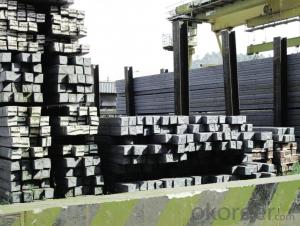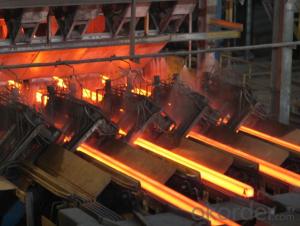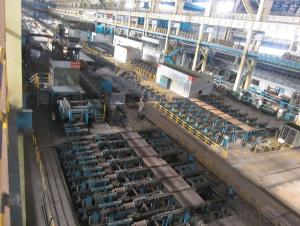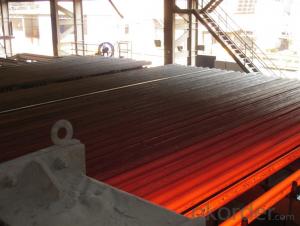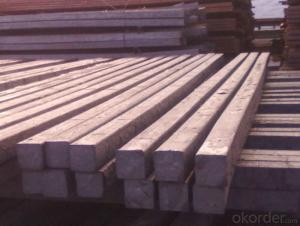Prime quality prepainted galvanized steel 685mm
- Loading Port:
- Tianjin
- Payment Terms:
- TT OR LC
- Min Order Qty:
- 100 m.t.
- Supply Capability:
- 10000 m.t./month
OKorder Service Pledge
OKorder Financial Service
You Might Also Like
Construction building material galvanized color prepainted cold
rolled steel coil
Prepainted steel sheet is coated with organic layer, which provides higher anti-corrosion property and
a longer lifespan than that of galvanized steel sheets.
The base metals for prepainted steel sheet consist of cold-rolled, HDG electro-galvanized and hot-dip
Alu-zinc coated. The finish coats of prepainted steel sheets can be classified into groups as follows:
polyester, silicon modified polyesters, polyvinylidene fluoride, high-durability polyester, etc
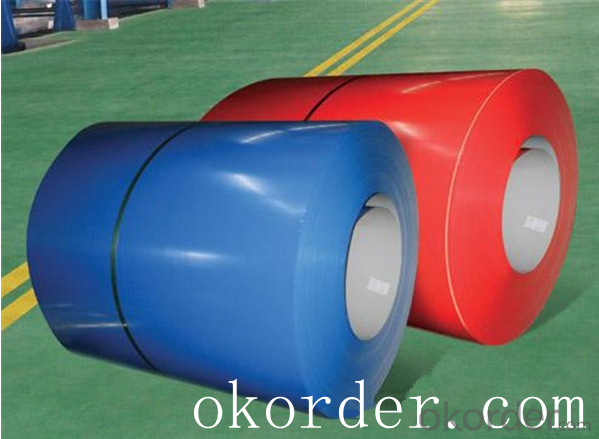
Standard and Grade :
Pre-paint galvanized steel coil | ||||
ASTM A755M-03 | EN10169:2006 | JISG 3312-2012 | ||
Commercial quality | CS | DX51D+Z | CGCC | |
Structure steel | SS GRADE 230 | S220GD+Z | CGC340 | |
SS GRADE 255 | S250GD+Z | CGC400 | ||
SS GRADE 275 | S280GD+Z | CGC440 | ||
SS GRADE 340 | S320GD+Z | CGC490 | ||
SS GRADE550 | S350GD+Z | CGC570 | ||
S550GD+Z | ||||
Application:
Outdoor | Roof, roof structure, surface sheet of balcony, frame of window, door of garage, rolled shutter door, booth, Persian blinds, cabana, etc |
Indoor | Door, isolater, frame of door, light steel structure of house, home electronic appliances, ect. |
Specifications
Commodity Name: Prepainted Galvanized Steel Coil
Standard: AISI, ASTM, DIN, GB, JIS
Grade: TDC52D+Z
Thickness 0.13-8.0mm
Width:600mm-1350mm
Zinc Coating:275g/m2
Polyester Coating Thickness:Top and Back coating thickness depend by Buyer Requirement.
Polyester Coating Type:2/2,1/2m,1/2.
Polyester Type: Polyester, silicone modified polyester, high durability polyester (HDP), polyvinylidene fluoride (PVDF)
Unit Roll Weight:5-20tons
Place of Origin Shanghai , China (Mainland)
Surface Treatment :Color Coated
Manufacture Progress:HRC-CRC-GALVANIZED-COLOR COATED
Application : Construction, electrical, transportation, steel plant, composite board plant, steel tile factory
Payment & Shipping Terms:T/T ,L/C, and FOB CHINA
Minimum Order Quantity: 25Tons
Packge Type: Moisture-proof paper inner,Steel outside,Bundle by steel rope.
Package in Container : Wood as a foot pad, wire rope reinforcement,PPGI steel coil tied together by steel rope.
- Q:What are the specifications for tool steel billets used in the automotive industry?
- The specifications for tool steel billets used in the automotive industry typically include requirements for hardness, toughness, wear resistance, and machinability. These billets are often required to meet specific international standards such as AISI (American Iron and Steel Institute) or DIN (Deutsches Institut für Normung) grades, which define the chemical composition and mechanical properties of the steel. Additionally, the billets may need to undergo specific heat treatment processes to further enhance their performance characteristics.
- Q:Can steel billets be used for making hand tools?
- Yes, steel billets can be used for making hand tools. Steel billets are essentially semi-finished steel products that are typically used for further processing and shaping into different forms. Hand tools such as wrenches, pliers, hammers, screwdrivers, and many others can be manufactured from steel billets. Steel is a popular choice for hand tool manufacturing due to its strength, durability, and resistance to wear and tear. Steel billets can be forged, machined, or heat-treated to create the desired shape, size, and hardness required for hand tools. The versatility of steel allows it to be easily molded into various tool designs, providing the necessary strength and functionality. Furthermore, steel hand tools offer several advantages over tools made from other materials. Steel's high tensile strength ensures that the tools can withstand high levels of force and pressure without breaking or deforming. Its resistance to corrosion and rusting makes steel tools suitable for both indoor and outdoor use, even in harsh environments. In conclusion, steel billets can indeed be used for making hand tools. The strength, durability, and versatility of steel make it an ideal material for manufacturing a wide range of hand tools that can withstand heavy usage and provide long-lasting performance.
- Q:What are the different forging techniques used for steel billets?
- There are several forging techniques used for steel billets, each offering unique advantages and producing different results. Some of the commonly used forging techniques for steel billets include: 1. Open Die Forging: This technique involves placing the steel billet between two flat dies and applying compressive force to shape it. Open die forging allows for a wide range of shapes to be formed, and it is often used for large and complex components. 2. Closed Die Forging: Also known as impression die forging, this technique uses shaped dies that contain impressions of the desired final shape. The steel billet is placed between the dies and compressed to conform to the die cavities. Closed die forging provides precise control over the shape and dimensions of the final product. 3. Roll Forging: In this technique, the steel billet is passed through two or more rotating rolls that exert compressive force to shape the material. Roll forging is commonly used for producing long cylindrical shapes such as bars, rods, and shafts. 4. Upset Forging: This technique involves compressing the steel billet axially to increase its cross-sectional area and reduce its length. Upset forging is often used to create thicker sections or to increase the diameter of the material. 5. Press Forging: Press forging utilizes hydraulic or mechanical presses to apply force to the steel billet, shaping it against the die. This technique allows for precise control over the forging process, making it suitable for producing components with intricate shapes or close tolerances. 6. Swaging: Swaging is a forging technique that involves reducing the diameter of a steel billet by applying radial compressive force using a series of dies. This process is commonly used to produce tapered or pointed components such as pins, bolts, or needles. Each of these forging techniques offers distinct advantages depending on the desired shape, size, and properties of the final product. The choice of forging technique is determined by factors such as part complexity, material properties, production volume, and cost considerations.
- Q:What are the different types of shearing machines used for steel billets?
- Steel billets can be cut using various types of shearing machines. These machines are designed for precise and efficient cutting operations in the steel industry. Here are some examples of the different shearing machines used for steel billets: 1. Guillotine Shears: Guillotine shears are widely used for cutting steel billets. They have a fixed bed and a vertically moving blade that cuts through the material. Guillotine shears offer high cutting accuracy and can easily handle thick billets. 2. Flying Shears: Also known as rotary shears, flying shears are another popular option. They have a circular blade that rotates and cuts the billet as it moves along the conveyor. Flying shears are known for their high cutting speed and ability to handle large volumes. 3. Cold Shears: Cold shears are designed to cut steel billets at lower temperatures to prevent heat damage. They use hydraulic or mechanical systems to apply force and cut through the billet. Cold shears are commonly used in industries where cooling the billets is necessary before further processing. 4. Rotary Shears: Rotary shears are used to cut steel billets into smaller sections. They have multiple blades mounted on a rotating drum, which cuts the billet into desired lengths. Rotary shears offer high cutting efficiency and are often used when small-sized billets are required. 5. Hydraulic Shears: Hydraulic shears are versatile machines that can cut various materials, including steel billets. They use hydraulic power to provide the cutting force. Hydraulic shears have a high cutting speed and can efficiently handle large-sized billets. Each type of shearing machine mentioned above has its own advantages and is suitable for specific applications in the steel industry. The choice of shearing machine depends on factors such as billet size and thickness, required cutting accuracy, production volume, and other specific requirements of the steel processing operation.
- Q:How are steel billets inspected for dimensional accuracy?
- Steel billets are inspected for dimensional accuracy using various methods such as calipers, micrometers, and laser measurement devices. These tools are used to measure the length, width, and height of the billets and ensure they meet the required specifications. Additionally, visual inspections are also conducted to check for any defects or irregularities in the shape and size of the billets.
- Q:Are steel billets subject to any heat treatment processes?
- Indeed, heat treatment processes can be used on steel billets. Heat treatment is a regulated procedure that involves heating and cooling metals in order to modify their physical and mechanical properties. Steel billets, which are semi-finished steel products with a square or rectangular shape, can undergo different heat treatment processes depending on the desired properties for the final product. One commonly used heat treatment process for steel billets is annealing. Annealing consists of heating the billets to a specific temperature and gradually cooling them to relieve internal stresses and enhance their ductility and toughness. This process is typically employed to soften the steel and make it more malleable for subsequent manufacturing processes. Another heat treatment process for steel billets is quenching and tempering. Quenching involves rapidly cooling the heated steel billets in a liquid medium, such as oil or water, to achieve high hardness and strength. However, this process results in a hard but brittle material. To reduce the brittleness, the quenched billets are then tempered by reheating them to a lower temperature and slowly cooling them. Tempering improves the toughness and ductility of the steel while maintaining a certain level of hardness. Additional heat treatment processes that can be applied to steel billets include normalizing, which involves heating the steel above its critical temperature and then cooling it in still air to refine the grain structure, and stress relieving, which is performed to reduce residual stresses in the billets after extensive machining or welding. Overall, heat treatment processes can significantly improve the mechanical properties of steel billets, making them more suitable for various applications in industries such as automotive, construction, and manufacturing.
- Q:How are steel billets used in the production of railway infrastructure?
- Steel billets are an essential component in the production of railway infrastructure. These billets, which are semi-finished steel products, serve as the starting material for the manufacturing of various railway components such as rails, sleepers, and fasteners. To begin with, steel billets are first heated to a high temperature and then passed through a series of rollers to shape them into the desired profile. This process, known as hot rolling, ensures that the billets are transformed into long and narrow sections with a consistent cross-section. These sections serve as the foundation for the construction of railway tracks. One of the primary uses of steel billets in railway infrastructure is the production of rails. After the hot rolling process, the billets are further processed to form rails of various lengths and dimensions. These rails are then used to create the track structure, providing a stable platform for trains to run on. The high strength and durability of steel make it an ideal material for railway tracks, ensuring that they can withstand heavy loads and frequent traffic. Steel billets are also utilized in the production of sleepers, which are the horizontal supports that hold the rails in place. The billets are shaped and formed into concrete or wooden sleepers, which are then laid on the track bed to provide support and stability to the rails. These sleepers play a crucial role in distributing the weight of the trains and maintaining the alignment and gauge of the tracks. Additionally, steel billets are used in the manufacturing of fasteners such as bolts, nuts, and clips. These fasteners are essential for securing the rails to the sleepers and ensuring that they remain in position during train operations. The high strength and resilience of steel make it a reliable material for these critical components, as they need to withstand substantial stress and vibrations. In conclusion, steel billets play a vital role in the production of railway infrastructure. Their versatility and strength make them suitable for creating rails, sleepers, and fasteners, which are essential components of a reliable and robust railway system. Without the use of steel billets, the construction and maintenance of railway tracks would not be possible, ultimately impacting the efficiency and safety of train operations.
- Q:What is the weight of a standard steel billet?
- The weight of a standard steel billet can vary depending on its dimensions and specific alloy composition. However, on average, a standard steel billet weighs around 1,000 to 1,500 kilograms or 2,204 to 3,307 pounds. It is important to note that different industries and regions may have their own standard sizes and weight ranges for steel billets.
- Q:What are the specifications for steel billets used in the aerospace industry?
- The aerospace industry demands highly precise and stringent specifications for steel billets. These billets must adhere to specific standards to guarantee the safety and durability of aircraft components. Firstly, the steel utilized for aerospace billets must possess outstanding strength and toughness. It must exhibit a high tensile strength and the ability to withstand extreme forces and stresses encountered during flight. Additionally, the steel must demonstrate excellent fracture resistance to minimize the risk of catastrophic failure. Moreover, the steel billets must possess exceptional resistance to corrosion and oxidation. This is crucial as aircraft frequently operate in harsh environments, such as high altitudes and exposure to various chemicals. The steel should resist rust, pitting, and other forms of degradation that can compromise its structural integrity over time. Furthermore, the steel billets employed in aerospace applications must exhibit precise dimensional tolerances and uniformity. They should be manufactured according to exact specifications to ensure consistency in the production of aircraft components. This entails precise size, shape, and surface finish, which are vital for proper fitting and assembly. Regarding chemical composition, the steel used for aerospace billets may vary depending on the specific application and component being manufactured. However, it typically includes elements like carbon, manganese, chromium, nickel, and molybdenum. These alloying elements enhance the mechanical properties of the steel, such as hardness, toughness, and heat resistance. Additionally, the steel billets utilized in the aerospace industry undergo rigorous testing and quality control procedures. This includes non-destructive testing methods such as ultrasonic inspection, magnetic particle inspection, and dye penetrant inspection to identify any internal defects or discontinuities. In summary, the specifications for steel billets used in the aerospace industry encompass exceptional strength, toughness, corrosion resistance, dimensional accuracy, and precise chemical composition. These stringent requirements ensure the reliability and safety of aircraft components, enabling them to withstand the demanding conditions experienced during flight.
- Q:How do steel billets contribute to the construction industry?
- Steel billets contribute to the construction industry by serving as the raw material for various steel products used in construction. These billets are transformed into beams, columns, rods, and other structural components that provide strength, stability, and durability to buildings and infrastructure. Additionally, steel billets are used in the manufacturing of reinforcements for concrete, enhancing the structural integrity of concrete structures such as bridges, highways, and buildings. Overall, steel billets play a crucial role in the construction industry by providing the necessary materials for safe and reliable structures.
1. Manufacturer Overview |
|
|---|---|
| Location | |
| Year Established | |
| Annual Output Value | |
| Main Markets | |
| Company Certifications | |
2. Manufacturer Certificates |
|
|---|---|
| a) Certification Name | |
| Range | |
| Reference | |
| Validity Period | |
3. Manufacturer Capability |
|
|---|---|
| a)Trade Capacity | |
| Nearest Port | |
| Export Percentage | |
| No.of Employees in Trade Department | |
| Language Spoken: | |
| b)Factory Information | |
| Factory Size: | |
| No. of Production Lines | |
| Contract Manufacturing | |
| Product Price Range | |
Send your message to us
Prime quality prepainted galvanized steel 685mm
- Loading Port:
- Tianjin
- Payment Terms:
- TT OR LC
- Min Order Qty:
- 100 m.t.
- Supply Capability:
- 10000 m.t./month
OKorder Service Pledge
OKorder Financial Service
Similar products
New products
Hot products
Related keywords
